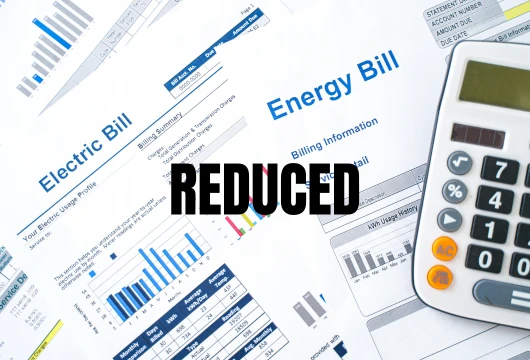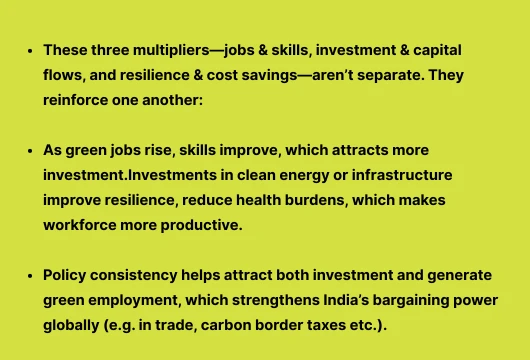A Sustainable Economy Drives Jobs, Investment, Resilience in India
The rising global urgency around climate change, resource scarcity, and environmental degradation is pushing countries to rethink their growth models. For India, a rapidly developing economy with a huge population and ambitious goals (net zero by 2070, 500 GW of non-fossil energy by 2030, etc.), sustainability isn’t just an ethical or ecological imperative—it’s an economic multiplier. What that means is investing in sustainable practices, green technologies, circular systems, and regulatory frameworks doesn’t just cost—it pays back in multiple, reinforcing ways.
In this article, we lay out three strong, interlinked reasons why embedding sustainability deep into India’s development trajectory will multiply its economic gains—far beyond environmental benefits. Each reason includes data or real examples, plus considerations and what needs to be done to fully reap the benefit.
Reason 1: Massive Job Creation & Green Skills Ecosystem
One of the clearest multiplier effects of sustainability is job creation, across both traditional sectors and emerging ones. For India, where employment and skills are central concerns, this is especially powerful.

A. What the Data Says
For instance, in FY25, jobs in waste management (especially e-waste, wastewater) were projected to rise by 20-16% in certain segments.
A report by the Skill Council for Green Jobs (SCGJ) and Sattva Consulting estimates that India employs ~20% of its workforce already in “green jobs.” This number is expected to roughly double by 2030.
Renewable energy, waste management, electric vehicles (EVs), sustainable construction, water & wastewater management are among the sectors seeing the largest growth.
B. Why It Multiplies Economy
Inclusive growth: Many green jobs can be localized—rural solar deployment, agro-ecological farming, waste management—helping reduce urban migration pressures.
- Multiplier through supply chains: Green sectors (solar, wind, EVs, green hydrogen) don’t just employ installers—they generate work for manufacturing, logistics, maintenance, R&D, services.
- Skill development & youth benefit: With a huge young population, investing in green skill training raises employability. It helps reduce structural unemployment and mismatch of skills.
- Inclusive growth: Many green jobs can be localized—rural solar deployment, agro-ecological farming, waste management—helping reduce urban migration pressures.

C. Real Examples to Illustrate
- India’s Green Hydrogen Mission (part of its renewable energy push) aims not only to decarbonize industry but also to create hundreds of thousands of jobs in manufacturing electrolyzers, deployment, engineering.
- Gujarat’s investment of Rs 29,000 crore in its Green Energy Corridor (GEC-III) to transmit 16,500 MW of clean power is generating new jobs in transmission line construction, maintenance, etc.
D. What Needs to Happen
To fully harness jobs as a multiplier:
- Green Skills Training & Certification: Upskilling programs, vocational training aligned with green industry needs.
- Inclusive employment policies: Ensuring women, rural youth, marginalized communities can access green jobs.
- Support MSMEs: Many green ventures will be local small businesses. Policies and finance must support them.
- Standards & regulations: For safe, quality, scalable green jobs, sectoral standards needed (e.g. EV charging, waste recycling).
Reason 2: Attracting Domestic & Foreign Investment
Sustainability is now central to investment decisions globally. For India, this means green strategies can be a magnet for capital, innovation, and global partnerships.

A. Signals from Investment Trends
The increasing interest in sustainability courses among students (which builds future talent) shows investor confidence that green sectors will grow.
India’s renewable energy sector has seen roughly $14.5 billion invested in FY22 alone, a >100% rise YoY in some reports.
The drive toward green bonds, green financing, sustainable infrastructure is rising. Surya Green Term Ahead Market (GTAM), for example, allows exchange and trading of renewable energy.
B. Multiplier Effects of Investment
- Technology & infrastructure maturation: Investments build capacity—for example, solar farms, electric grid modernization, hydrogen, waste-to-energy—all require large capex but once established, they reduce energy costs, improve reliability, reduce import dependency.
- Reduced import bills & increased energy security: As India shifts to renewables, green hydrogen, etc., dependence on imported fossil fuels shrinks. This improves trade balance, reduces vulnerability to global fuel price volatility.
- Improved public health & reduced healthcare costs: Clean air, water, less pollution lower disease burden, saving public expenditure, improving productivity.

C. Real Examples to Illustrate
- India’s Green Hydrogen Mission (part of its renewable energy push) aims not only to decarbonize industry but also to create hundreds of thousands of jobs in manufacturing electrolyzers, deployment, engineering.
- Gujarat’s investment of Rs 29,000 crore in its Green Energy Corridor (GEC-III) to transmit 16,500 MW of clean power is generating new jobs in transmission line construction, maintenance, etc.
D. What Needs to Happen
- Stable Policy & Regulatory Environment: Investors need predictability—consistent renewable energy policies, tariffs, grid access, clear approval norms.
- Green Finance Instruments: Scaling up green bonds, blended finance, concessional funding, climate funds.
- Risk Mitigation: Insurance, guarantees, de-risking of early-stage green projects.
- Local Innovation: Encouraging domestic R&D so investment also builds local capacity.
Reason 3: Resilience, Health & Long-Term Cost Savings
Last but not least, sustainability builds resilience—both environmental and economic. It reduces risks, cuts long-term costs, improves quality of life, which in turn supports economic productivity.

A. Health, Environment & Social Benefits
Sustainable land & water use reduces risk of crop failure, droughts, flood damages—vital for India’s agrarian population.
Pollution (air, water, soil) has large economic costs: healthcare spending, lost workdays, reduced life expectancy. India’s move to cleaner energy, stricter emission norms, and greener transport systems helps reduce these burdens.

B. Cost Savings Over Time
- Energy efficiency: UJALA LED bulb program in India reduced power usage and saved millions of tonnes of CO₂; reduces electricity bills for households.
- Renewable energy becoming cheaper in many places than coal or diesel generation. So at scale, renewables lower long-term energy cost for industries, consumers, government.
- Avoided costs from climate damages: infrastructure repair, disaster relief, supply chain disruptions.
C. Examples
- The Bhadla Solar Park in Rajasthan (2,245 MW) reduces millions of tonnes of CO₂ annually and helps reduce dependence on fossil fuel thermal power generation. (Wikipedia)
- Deployment of non-fossil capacity: India’s installed capacity of non-fossil fuel sources is ~172.72 GW, helping reduce carbon intensity and energy import dependence. (Invest India)
D. What Needs to Happen
- Integrate climate risk into planning: Infrastructure, policy, urban planning need to embed resilience.
- Public health linkage: Recognize sustainability as a driver to reduce burden on healthcare systems.
- Cost-benefit evaluation & Green GDP: Use metrics that internalize environmental and social benefits/costs (e.g., Green GDP) in policy.
- Community participation: Ensuring local areas benefit from green infrastructure, clean energy, resilience.
Synthesis: How These Three Reasons Reinforce Each Other

Challenges and Risks: What Could Undermine the Potential
To be realistic, India will need to address some impediments to ensure these multipliers fully materialize:
- Skill mismatches: Green job growth demands specific new skills; education and training need to catch up.
- Finance gaps: Large upfront capital requirement; need for de-risking, credit access especially for smaller firms and rural areas.
- Policy stability & coherence: State policies sometimes conflict, subsidies out of date, regulatory hurdles. Example: Some states scrapped clean energy incentives (e.g., Assam clean energy policy) which could discourage investors.
- Infrastructure constraints: Grid stability, storage, transmission bottlenecks, resource availability (water, rare materials).
- Equity concerns: Ensuring benefits reach marginalized populations—not just major firms or urban centers.
Seizing the Multiplier Moment
Sustainability is often cast as a cost or trade-off. But for India, it is increasingly clear that embracing sustainability is an investment—one that multiplies returns in multiple dimensions.
To recap, the three main multiplier benefits are:
- Massive job creation & skill enhancement
- Attraction of domestic & foreign capital
- Health, resilience & long-term cost savings
With the right strategies—education & training, stable policy, financing mechanisms, infrastructure, equity focus—India can convert its sustainability ambitions into lasting economic strength.
As India strides toward its net zero pledges and global environmental commitments, it’s not just about “saving the planet”—it’s about multiplying livelihoods, growth, and global economic leadership.
For more inspiring Blogs, click here

